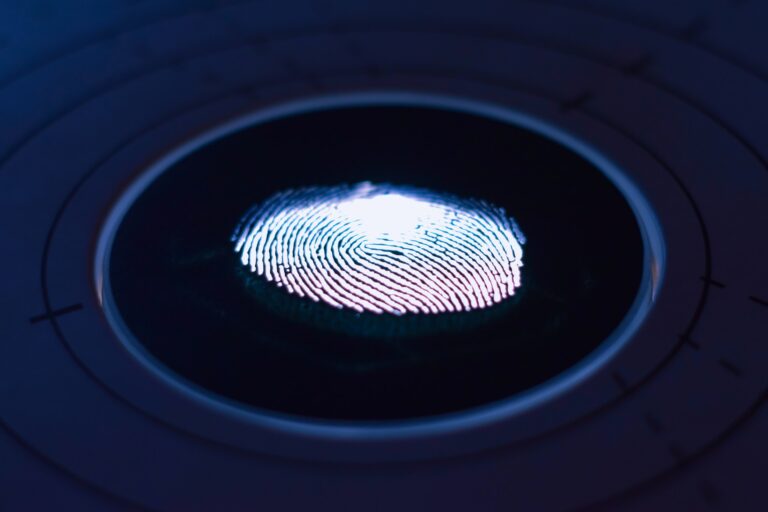Biometrics refers to the automated methods of identifying or authenticating a person’s identity based on their unique physiological or behavioral characteristics. Examples include fingerprints, facial patterns, voice or retinal scans, and hand measurements.
At the heart of this identification system lies a simple idea: every person is unique. This uniqueness isn’t just about looks or personality. It’s in the details too. The ridges on your fingertips. The pattern of your irises. The sound of your voice. Even the way you type on a keyboard. These are all biometrics.
Biometrics harnesses this individuality. It uses technology to measure these unique traits. But why? For identification and verification. Biometrics can confirm who you are (identification) or check you are who you say you are (verification).
Table of Contents
The types of biometrics
There are two types of biometrics:
1. Physiological biometrics
Physiological biometrics rely on our body’s physical characteristics. These are traits that are unique to each individual. They’re often stable throughout a person’s life. Examples include fingerprint patterns, facial recognition, iris or retina patterns, and DNA. Due to their uniqueness and stability, they are often used in high-security scenarios.
2. Behavioral biometrics
On the other hand, behavioral biometrics focuses on the unique ways we perform actions. These traits are typically learned and acquired over time. They might not seem unique at first glance. Yet, they are often distinctive enough to differentiate between individuals. Examples include the rhythm of typing, how we walk (gait), or even how you sign your name. While not as permanent as physiological traits, they provide a dynamic layer of security.
Each type of biometric data has its strengths and potential applications. They often work best when used together, providing a multifaceted approach to security and identification.
How biometrics work
Biometrics operate through a two-step process: Enrollment and Verification or Identification.
1. Enrollment
This is the initial stage. Here, the biometric system records the user’s unique physical or behavioral traits. This data is then processed and stored in a database as a biometric template. For example, when you set up fingerprint recognition on a new phone, the phone scans and stores the data from your fingerprint. This stored data forms the benchmark for future comparisons.
2. Verification or identification
Now, when a user interacts with the system, it captures a new biometric sample. This could be a new fingerprint scan or a facial recognition scan. The system then compares this new data with the stored biometric template.
In both scenarios, the system confirms the identity of the new sample, and the stored template match within a certain threshold. If not, access is denied. This process helps ensure that only authenticated users gain access to systems, buildings, or data.
Read also: Digital identity: types, examples, and latest developments
The different Use Cases of Biometrics
Biometrics have a wide range of applications across various industries:
- Security and law enforcement: Law enforcement agencies worldwide use biometrics for identification and verification purposes. For instance, fingerprint and facial recognition systems help identify criminals. DNA biometrics is invaluable in forensic investigations. On the security front, biometrics offer a robust layer of protection in access control systems, both for physical premises and digital systems;
- Healthcare: In the healthcare sector, biometrics enhance patient safety and privacy. Patient identification systems can use biometric data to ensure that medical records are securely linked to the right patient. Biometrics can also aid in remote patient monitoring, confirming that the right patient is using the medical device or receiving the medication;
- Consumer electronics: Biometrics are now commonplace in our smartphones, laptops, and smart home devices. From unlocking your phone with a fingerprint or facial scan to voice-controlled smart home devices, biometrics adds a layer of security and convenience to consumer electronics;
- Banking and finance: The financial sector uses biometrics to combat fraud and enhance customer experiences. Banks use fingerprint, facial recognition, or voice biometrics for authentication in online transactions. This provides a better user experience and adds an extra layer of security to protect customers’ financial data.
Advantages and disadvantages of biometrics
Advantages
- Increased security: Biometric identifiers are unique to individuals, making them very secure. It’s extremely difficult to forge or steal biometric data compared to passwords or ID cards;
- Convenience: Biometric systems provide convenience. There’s no need to remember passwords or carry ID cards. Your face, fingerprint, or voice becomes your access pass;
- High accuracy: Biometric systems offer high accuracy. False matches are very rare due to the unique nature of biometric data.
Disadvantages
- Privacy concerns: It involves collecting sensitive personal data. There are valid concerns about storing, using, and protecting this data;
- Potential for misuse: If biometric data falls into the wrong hands, it could be misused. Unlike passwords, you can’t change your biometric data;
- Technical limitations: While biometrics technology has improved significantly, it’s not flawless. For example, facial recognition systems might struggle with changes in lighting or aging. Fingerprint scanners might fail with dirty or injured fingers.
Biometrics will shape our future in unimaginable ways
Biometrics represents a potent blend of science and technology, reshaping our world by offering secure and unique identification methods. Its applications span industries, enhancing security and user experiences from law enforcement and healthcare to consumer electronics and banking.
Yet, it’s not without challenges—privacy issues, potential misuse, and technical limitations underline the need for cautious implementation and robust safeguards.
As we keep up with the latest developments, we see a realm continually evolving, brimming with innovation, and raising pivotal questions about privacy and security. This journey into the intriguing world of biometrics promises to shape our future in unimaginable ways, so stay tuned for more insights.
Read also: Artificial Intelligence, the European Parliament approves the first regulation ever












